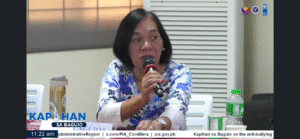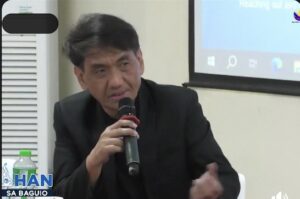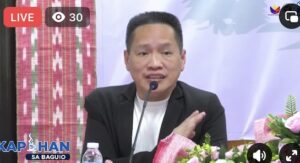Bullies are Bred at Home says Bullying Case Studies
Ms. Annie Caguioa Executive Director of Baguio City Schools Association of Private Schools (BCAPS) at the Kapihan on the Anti-Bullying Act.
By: Nonnette Bennett
Bullies are bred at home, according to Executive Director of Baguio City Schools Association of Private Schools (BCAPS) Ms. Annie Caguioa based on case studies of bullying in private schools in Baguio City. The background stated during the 14 October 2025 Kapihan on the Anti-Bullying Act at the Department of Education Schools Division Office with the Philippine Information Agency (PIA).
Caguioa said that this situation was observed as a common factor among reported cases in the private schools. She said that the increased reports of the incidents of bullying in the schools found out that the bullies belonged to homes where the parents are busy and children left unsupervised, homes where the parent or parents are Overseas Filipino Workers (OFW) and they are left with grandparents, siblings are bullies themselves, or they belong to dysfunctional families.
She said that there is a need for the Local Government Unit to hire more Child Development Specialists who can help the children overcome their violent behavior because it takes four months before these children can be attended to by professionals. The CDS are specialized guidance counselors who can respond to the needs of the children and help them overcome misbehavior.
City Council Education Committee Chair Councilor Vladimir Cayabas.
SDO Legal officer Atty. Annette Doyaoen said that the new Implementing Rules and Regulations (IRR) of RA 10627 or the Anti-Bullying Act of 2013 defines bullying as severe or repeated acts that cause physical or emotional harm, create a hostile environment, or disrupt the educational process, including physical contact, verbal abuse, cyberbullying, gender based and social exclusion.
FPTA President Peter Wasing.
She said that there are three Bs in bullying – the bully, the bullied, and the bystanders. These three are included in the Child Protection Policy of the new IRR of the Anti-Bullying Act. There are interventions recommended.
Councilor Edison Bilog, author of City Ordinance on Anti-Bullying
Councilor Edison Bilog, author of the Baguio City Ordinance on “Bullying”, noted that the law penalizes not just the committer but even the teachers and principals. He said that the ordinance includes “chismis” or false stories about a student to destroy reputation or character is defined as social bullying. Sexual bullying is touching or holding sensitive body parts and cyberbullying as text messages or the use of social media. He added that the cases can be resolved in the schools and actions could be taken like the transfer of the victim to another school or the suspension of the perpetrator.
City Council Education Committee Chairman Vladimir Cayabas said that there is a need to entice psychology graduates to become guidance counsellors given the requirement to complete their masteral studies before the board exam. The city needs to provide incentives for the specialized profession.
Federation of Parents-Teachers Associations (FPTA) president Peter Wasing said even parents are bullies when they tell their children to retaliate to the slaps and kicks that they receive, “lipakkem”, “kudtaram”. He said that at the Magsaysay Elementary School, the PTA conducts a seminar on “Parenting” with the City Social Welfare and Development Office (CSWDO) before the distribution of report cards. He said the federation can go to the family of the victim or bully to give the parents advice.
Eldon Soriano, Guidance Counsellor of Pines City National High School, said that the bully often wants attention because he/she belongs to a dysfunctional family or the parents are out. Sometimes the parents who compare their children are also the cause of the violent behavior because of the negative self-esteem of the pupil. He said that some mothers express that they “give up” on the child. This makes it difficult to find solutions to the situation.
Caguiao said that the solution to bullying starts in the family. How does a parent become a parent not knowing their responsibilities. The teacher and the people around are all responsible for the development of the child. “It takes a village to raise a child,” she said. Collaboration of the different individuals around the young must help to solve bullying. When the child goes out of the campus, the police and the barangay should be on watch after classes, she suggested.
It takes a village to raise a child






